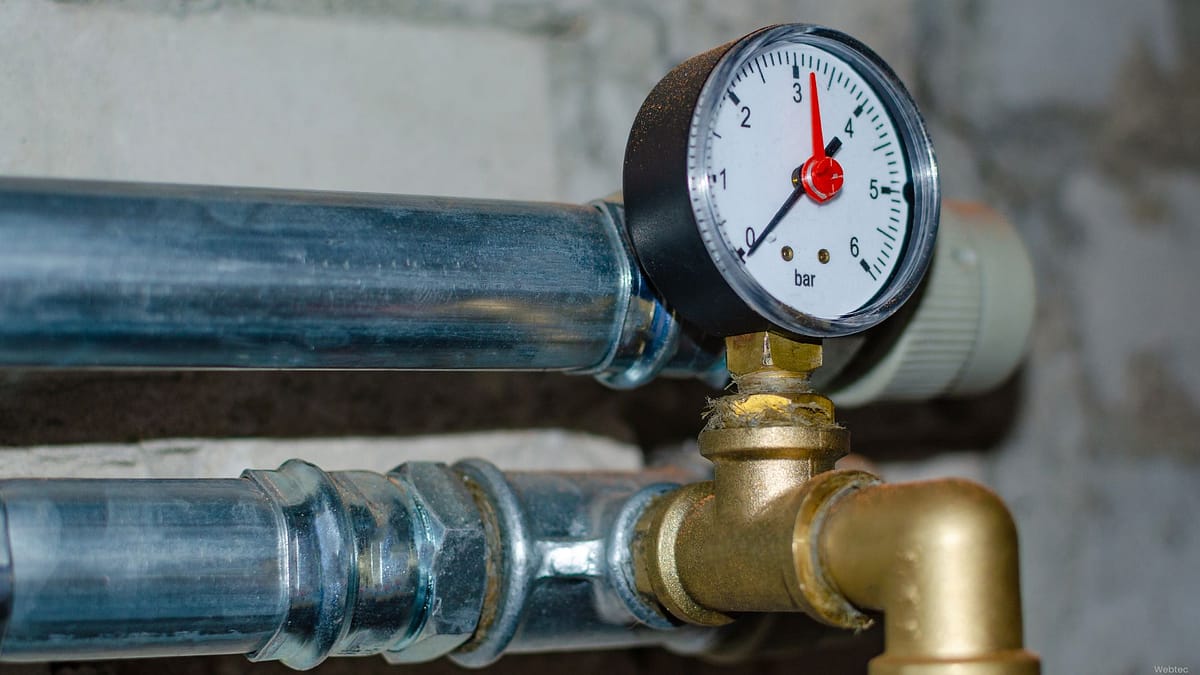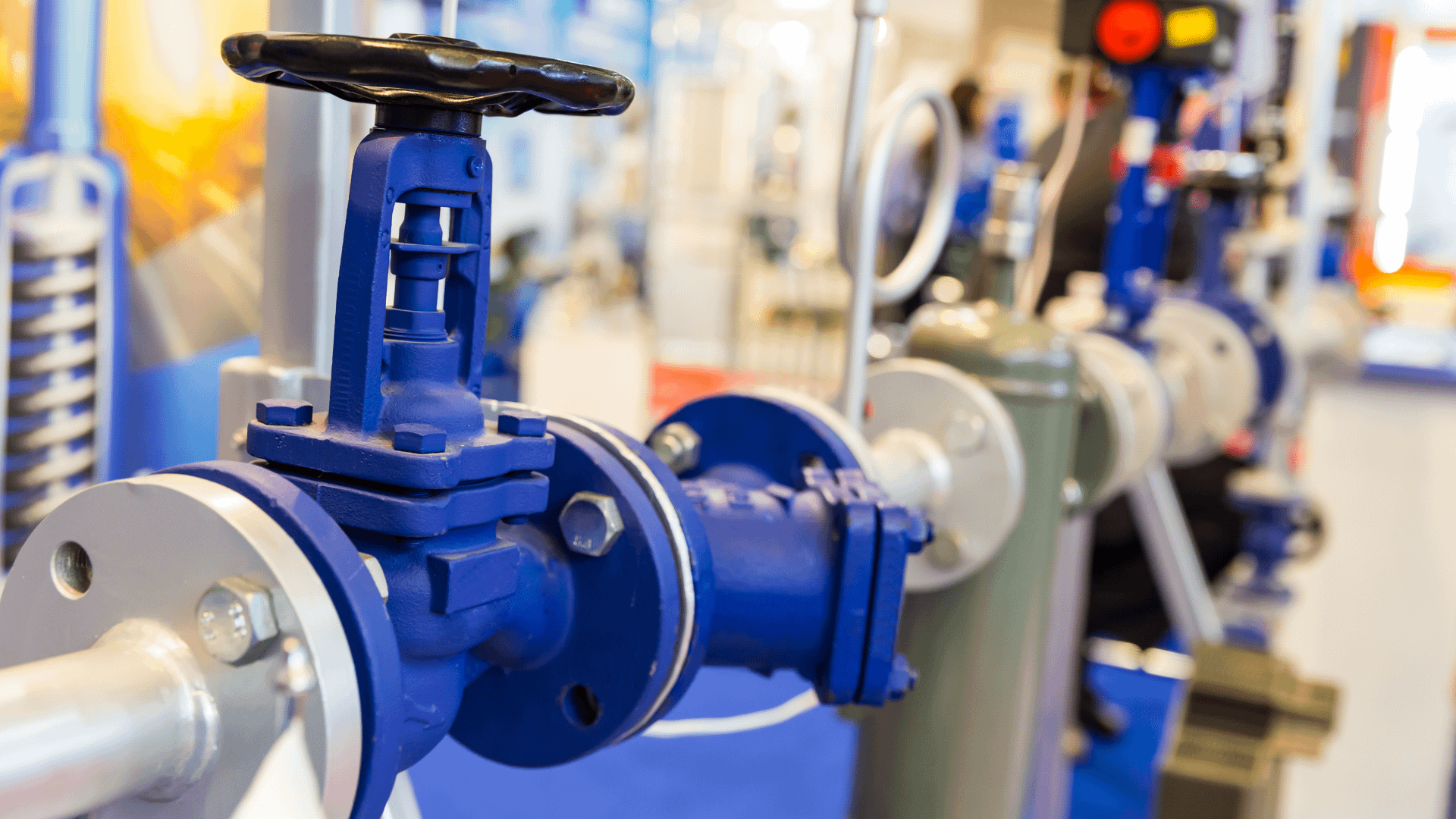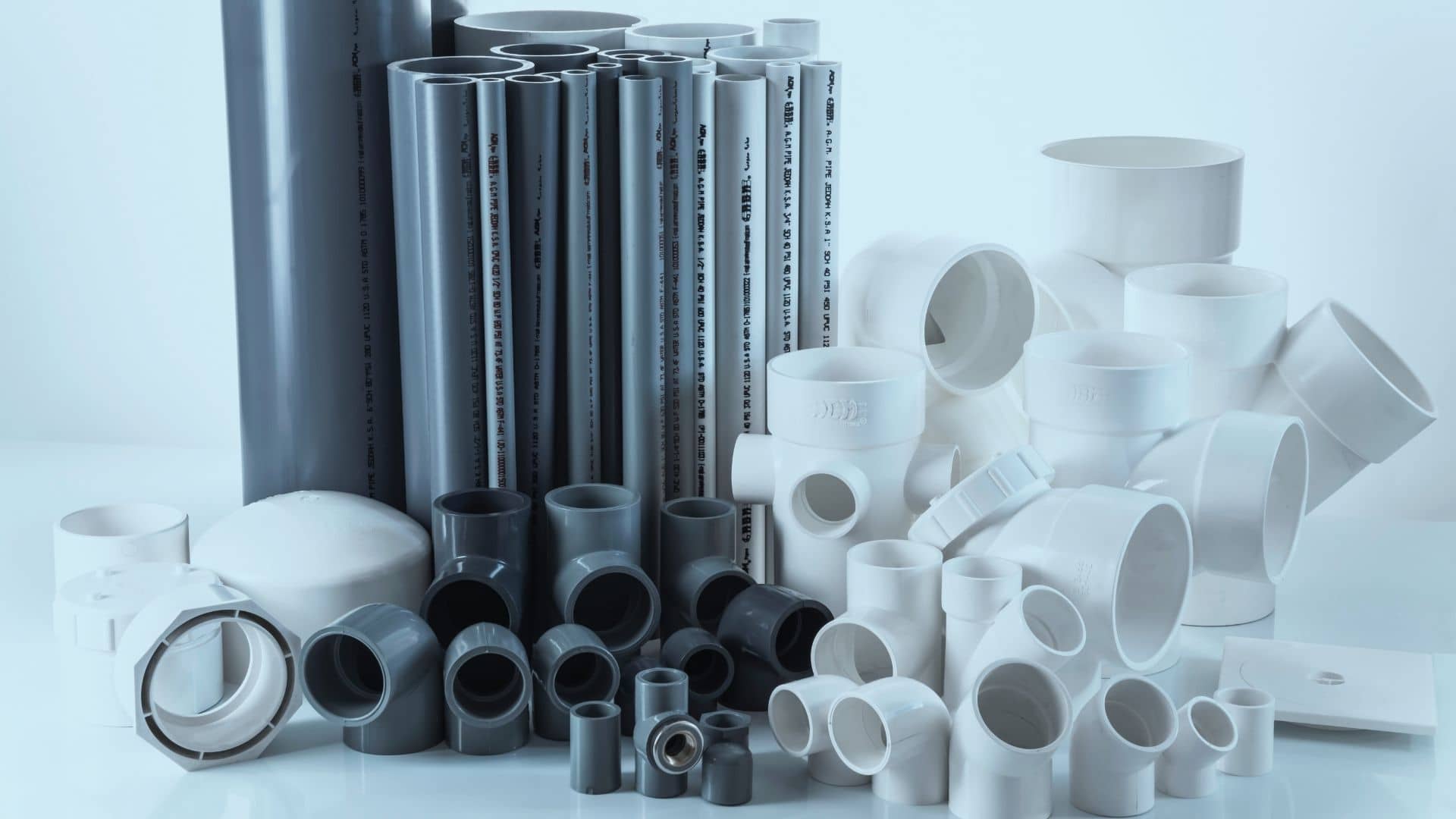Pressure-reducing valves control water pressure in buildings and industrial settings. These valves, when not working properly, can cause serious damage to piping, fixtures, and equipment.
Testing the PRV will help identify a problem before it gets too expensive to repair. This guide contains everything that you need to know about pressure-reducing valve testing and why it matters to your system.
What is PRV Testing?
PRV testing is a process that verifies the correct operation of pressure-reducing valves. The test measures how well the valve controls water pressure in your system.
During PRV testing, technicians use water pressure gauges to measure pressure before and after the valve. They also check if the valve opens and closes properly when pressure changes.
The test shows if your PRV maintains the right pressure levels. A good PRV keeps pressure steady even when water demand changes in your building.

Why is PRV Testing Important?
PRV testing protects your plumbing system from harm. Excessive pressure high up in the system may cause pipes to burst, fixtures to get damaged, or places to get flooded.
Regular testing also helps you follow local building codes. Most areas require PRV inspection to keep your building permits valid.
Testing saves money by catching problems early. A small repair costs much less than replacing an entire plumbing system after a major failure.
What Are the Benefits of PRV Testing?
- Prevents Costly Water Damage
PRV testing stops pressure problems before they damage your property. High pressure can destroy pipes, appliances, and fixtures in minutes.
- Extends Equipment Life
Proper pressure control makes your plumbing last longer. Pressure gauge calibration ensures accurate readings for better system protection.
- Maintains Water Efficiency
Working PRVs help control water flow and reduce waste. This cuts your water bills and helps the environment.
- Meets Safety Requirements
Regular testing keeps your building safe and code-compliant. Many insurance companies require PRV testing for coverage.
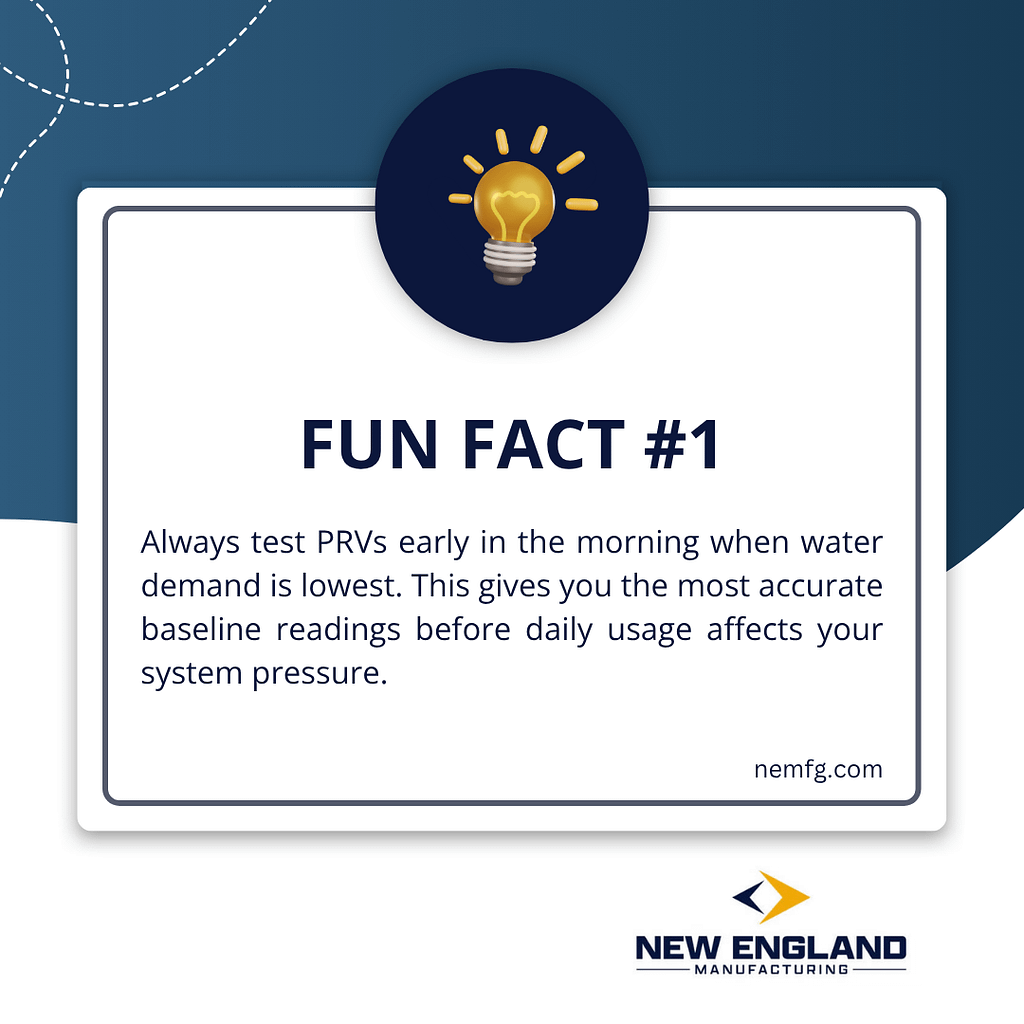
PRV Test Procedure Steps
- Pre-Test Preparation
Check your PRV location and access points. Most valves are near the main water line where it enters your building.
Turn off the water to fixtures downstream of the valve. This prevents pressure spikes from affecting your test results.
- Testing Equipment Setup
Install a water pressure gauge upstream of the PRV. This measures the inlet pressure coming into the valve.
Connect a second gauge downstream of the valve. This shows the outlet pressure that goes to your building.
- Pressure Measurement Process
Record the static pressure with no water flow. This gives you baseline readings for both inlet and outlet sides.
Open several fixtures to create water flow. Check how pressure changes when demand increases or decreases.
Test the valve at different flow rates. Good PRVs maintain steady outlet pressure even when inlet pressure varies.
Test Condition | Inlet Pressure | Outlet Pressure | Pass/Fail |
No Flow | 80 PSI | 50 PSI | Pass |
Low Flow | 78 PSI | 50 PSI | Pass |
High Flow | 82 PSI | 52 PSI | Pass |
Peak Flow | 85 PSI | 55 PSI | Fail |
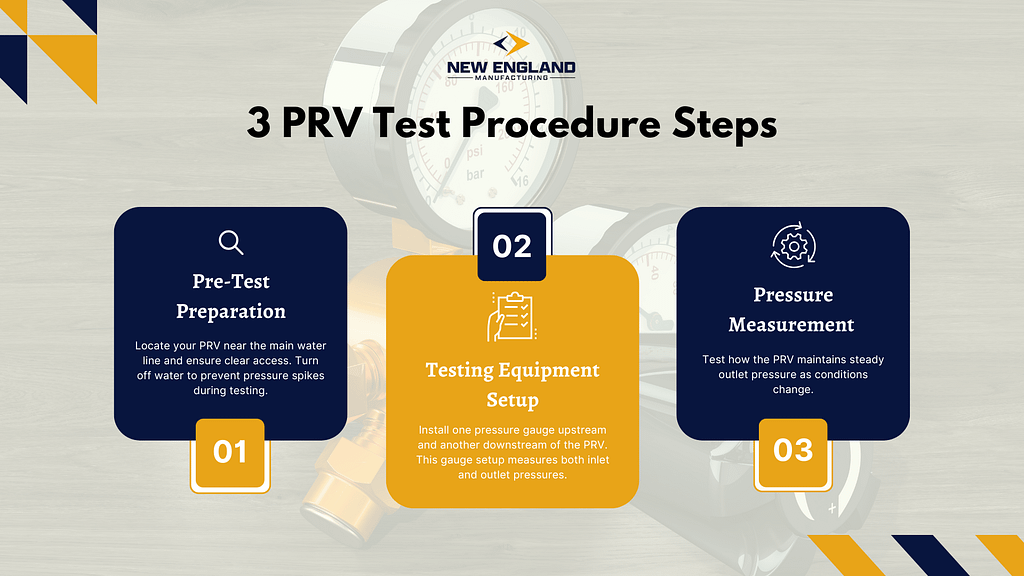
PRV Test Requirements by System Type
- Residential Systems
Home PRVs typically need testing every 3-5 years. Check local codes for specific requirements in your area.
Most residential valves should maintain 50-60 PSI outlet pressure. Higher pressure can damage household fixtures and appliances.
- Commercial Buildings
Commercial PRVs need more frequent testing due to higher usage. Many buildings test these valves annually or every two years.
Fire pump testing often includes PRV checks since these systems need reliable pressure control. Fire protection systems cannot work properly with the wrong pressure levels.
- Industrial Applications
Industrial PRVs may need monthly or quarterly testing. These systems often have multiple valves that work together.
Process equipment requires exact pressure levels to work safely. Regular PRV testing prevents production problems and equipment damage.
Common PRV Test Problems and Solutions
- Pressure Drift Issues
Pressure drift happens when outlet pressure slowly changes over time. This usually means internal valve parts are wearing out.
Replace the diaphragm or spring inside the valve. These parts handle the actual pressure control function.
- Chattering or Vibration
Valve chattering creates noise and can damage the valve body. This often happens when the inlet pressure is too close to the outlet pressure.
Check your fire hydrant flow test results to verify system pressure. You may need a different valve size or setting.
- Complete Pressure Loss
Total pressure loss means the valve is stuck open or has completely failed. This is a serious safety issue that needs immediate attention.
Shut off the main water supply and replace the valve. Do not try to repair a completely failed PRV.
PRV Inspection and Maintenance
- Visual Inspection Points
Check the valve body for cracks, corrosion, or leaks. Look at all connections and fittings around the valve.
Inspect the pressure relief port on the valve side. This port should be clear and not constantly dripping water.
- Maintenance Schedule
Clean the valve strainer every 6 months. Debris in the strainer can affect pressure control and cause valve failure.
Replace internal parts every 5-7 years or when testing shows problems. Keep spare parts on hand for quick repairs.
Maintenance Task | Frequency | Tools Needed |
Visual Inspection | Monthly | None |
Strainer Cleaning | 6 Months | Wrench Set |
Pressure Testing | Annual | Pressure Gauges |
Parts Replacement | 5-7 Years | Valve Kit |
PRV Test Kit Components
- Essential Testing Tools
A complete PRV test kit includes calibrated pressure gauges for accurate readings. Pressure gauge calibration ensures your test results are reliable.
You also need hoses, adapters, and shut-off valves. These connect your gauges to the system test ports.
- Advanced Testing Equipment
Digital pressure loggers record pressure changes over time. These help find problems that only happen at certain times or conditions.
Flow meters measure water flow during testing. This helps you understand how the PRV performs under different demand levels.
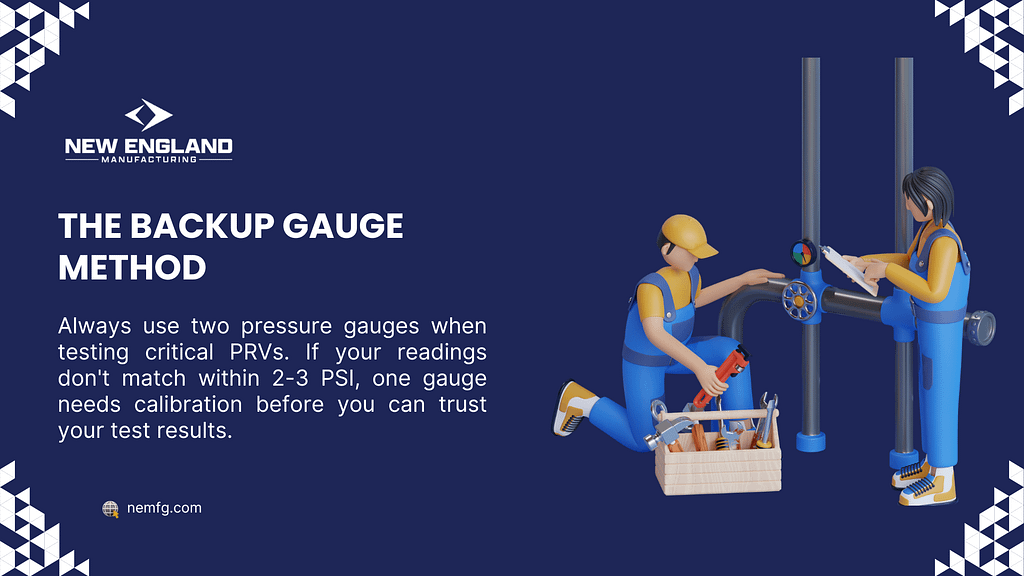
Safety Considerations During PRV Testing
- Water Pressure Hazards
High water pressure can cause serious injuries. Always wear safety glasses and work gloves when testing PRVs.
Never put your face near test connections. Pressure release can spray water and debris at dangerous speeds.
- System Shutdown Procedures
Know how to shut off the main water supply quickly. Emergency shutoffs prevent flooding if something goes wrong during testing.
Tell building occupants about the test schedule. People need to know when water service might be interrupted.
- Electrical Safety
Some PRV systems have electrical controls or sensors. Turn off power to these systems before starting your test.
Check for wet conditions around electrical components. Water and electricity create deadly combinations.
When to Call Professional Help
- Complex System Testing
Multi-valve systems need professional testing. These setups have complicated interactions between different pressure zones.
Fire hydrant testing professionals often handle building PRV systems too. They understand how all the parts work together.
- Calibration Services
Professional calibration services ensure your test equipment gives accurate readings. Wrong readings can lead to dangerous pressure problems.
Send your gauges for calibration every year. This keeps your testing reliable and meets most regulatory requirements.
- Emergency Repairs
Call professionals for emergency PRV failures. These situations can cause flooding or leave your building without water.
Do not attempt repairs on high-pressure systems without proper training. Mistakes can cause injuries or property damage.
Case Study: Office Building PRV Failure
A 10-story office building had water pressure complaints on the upper floors. The facility manager noticed weak flow from faucets and fountains.
Testing revealed the main PRV was stuck partially closed. Inlet pressure was 85 PSI, but outlet pressure had dropped to 30 PSI.
The building replaced the PRV diaphragm and spring. Post-repair testing showed proper pressure control with 50 PSI outlet pressure at all flow rates.
Case Study: Manufacturing Plant Success
A food processing plant installed new PRVs as part of a system upgrade. They wanted to prevent equipment damage from pressure spikes.
Monthly PRV testing showed consistent pressure control over six months. The plant avoided three potential equipment failures that would have cost $50,000 each.
Regular testing helped them catch small problems before they became major issues. This saved money and prevented production delays.
Cost Analysis of PRV Testing
- Testing Costs vs. Repair Costs
Professional PRV testing costs $200-500 per valve. Emergency repairs after failure can cost $2,000-10,000 plus water damage.
Regular testing saves money by preventing major failures. The cost of testing is much less than emergency repairs and cleanup.
- Equipment Investment
A basic PRV test kit costs $300-800. This pays for itself after testing just a few valves.
Professional-grade equipment costs more but lasts longer. Consider your testing frequency when choosing equipment.
Cost Item | DIY Testing | Professional Service |
Initial Equipment | $500 | $0 |
Per Test Cost | $0 | $300 |
Annual Cost (4 tests) | $500 first year, $0 after | $1,200 |
Emergency Repair Risk | High without training | Low with regular service |
Technology Advances in PRV Testing
- Smart Monitoring Systems
New PRV systems include sensors that monitor pressure continuously. These systems alert you to problems before they cause damage.
Smart systems connect to building automation networks. This lets you track PRV performance from your computer or phone.
- Remote Testing Capabilities
Some PRV systems allow remote testing and adjustment. This saves time and reduces the need for physical access to valves.
Remote systems are especially useful for PRVs in hard-to-reach locations. You can test these valves without special equipment or confined space procedures.
Regulatory Compliance and Standards
- Building Code Requirements
Most building codes require PRV testing for new construction and major renovations. Check local requirements for your specific area.
Some codes specify testing frequency and procedures. Follow these requirements to maintain your building permits and insurance coverage.
- Industry Standards
Professional organizations publish PRV testing standards. These documents provide detailed procedures and safety requirements.
Follow recognized standards even if not required by local codes. This ensures thorough testing and reduces liability risks.
Future Trends in PRV Testing
- Predictive Maintenance
New testing methods can predict when PRVs will fail. This lets you replace parts before they break instead of after.
Data analysis helps identify patterns in PRV performance. This information guides maintenance schedules and equipment choices.
- Integration with Building Systems
PRV testing is becoming part of the overall building system monitoring. This provides better information about how all systems work together.
Fire pump testing and PRV testing often happen together. This gives a complete picture of your building’s pressure control systems.
Key Takeaways for PRV Testing Success
What we can say as a conclusion is that PRV testing protects your property and saves money through early problem detection. And this testing can prevent many emergency repairs and water damage that can be expensive.
Make sure to use the right equipment and follow the safety procedures so you can get the accurate results you wish for. Also, if you don’t have the right experience when it comes to PRV testing and maintenance, you can consider professional services.
Keep detailed records of all testing and maintenance. This documentation will help you with insurance claims and regulatory compliance. Contact our team for professional testing services and calibrated equipment. We provide water flow test equipment and expert support for all your pressure testing needs.

